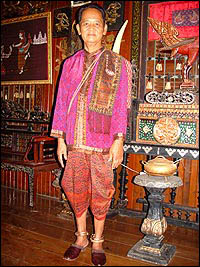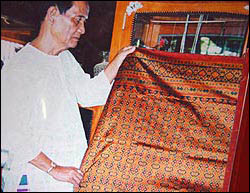- Home
- Article
- Culture
Khmer Culture
"I want younger generations to love Khmer artifacts, to keep them in Cambodia" Liv Saa Em said.

Khmer Traditional Clothing
The lines of culture distinguishing one country from another are blurring. The globalization of technology, information and finance has allowed wealthy countries to export not only their political and economic ideologies to developing countries but their traditions and values as well.
The Cambodian government has made aggressive rhetorical efforts to preserve the integrity of traditional Khmer culture, but younger generations are hungry for a change.
In a seemingly uphill battle to maintain cultural identity in an increasingly homogeneous global community, one man has made it his mission to preserve the past for future generations.
From household items and clothes to jewelry and sculpture, Liv Saa Em's private collection is one of the largest in Cambodia. "It is my favorite thing to do since I was young. I like to keep antiques in my house because my parents bought a lot of antiques from villagers to keep at their house.
Upon first glance, Liv Saa Em could be mistaken for an ancient Khmer man in his traditional dress. Ancient relics adorn his house as well, stretching from the front door into the darkest corners. The building is his sanctuary; a place Liv Saa Em says keeps him smiling. Visitors to the house, which doubles as a museum, often have offered the collector money for his goods. But Liv Saa Em's mission is to maintain Khmer culture for Cambodia. His message: History is not for sale.
The robbery of Khmer artifacts, for sale to foreign countries, is a rising concern. In efforts to preserve the integrity of Cambodia's tangible history, the Ministry of Culture and Fine Arts recently prohibited the exportation of artifacts from Cambodia to Vietnam and Thailand. Liv Saa Em agrees with the act's passage, as he too works to preserve artifacts so that all of Cambodia may enjoy them in years to come.

Khmer silk collection
Since the tender age of 13, Liv Saa Em has taken the cue of his parents, who were avid collectors. Now preserving artifacts is not only a hobby--it's a mission. "I'm very upset when I see our artifacts exported to neighboring countries," he said. "We know that they are really Khmer artifacts, but I have no ability to take them back to the country."
Even when it is not in transit, safeguarding art is not always easy. Liv Saa Em said artifacts kept in the National Museum cannot be promised security, and his house in Tang Yab, Prey Kabas district of Takeo province is no better. Pieces of history were shattered in 1976 when young Khmer Rouge soldiers destroyed his parents' house and the artifacts in it.
Unable to forget the loss, Liv Saa Em has made a conscious effort to buy pieces for his private collection at home. Trading medicine or rice for art, the collector has purchased relics from Takeo, Kampong Speu and Phnom Penh. Now Liv Saa Em's reputation for collecting precedes him, and tourists that visit his home hoping to make a purchase are always denied.
"I love Khmer artifacts and I love to keep them forever," Liv Saa Em said.
Liv Saa Em's love affair with the past started when he was just a boy. "I wore simple cloth like other people when I was young," he said. But after completing his studies, Liv Saa Em developed a style of his own. Entering adulthood, he wore the ancient Khmer cloth donned by people of the Funan period and shaved his head so that only a tuft of hair sat atop the middle of his crown.
Businessmen raised Liv Saa Em, the youngest son of a nine-member family that often dressed in traditional Khmer clothing. He was the most beloved of the lot then. Today he is alone. Liv Saa Em's brothers, sisters and parents perished during the war.
Struggling to overcome the loss of his family, Liv Saa Em filled his time honing his skills as a silk maker. He mixes together a rainbow of colors to produce the vibrant fabric that is exported to Japan today and earned him the Ministry of Culture and Fine Arts' Award for Best Quality Producing in 1993. His Excellency Nut Narang, the former Minister of Culture and Fine Arts, personally recognized Liv Saa Em as the first successful producer of best quality silk following Pol Pot's regime. His creativity is unceasing. Liv Saa Em rearranges the relics in his house to assume a new look every week. In the afternoon visitors can find the collector sitting amidst his artifacts, which he says are a comfort to him. The house, an increasingly popular tourist destination, has drawn curious visitors from around the country and the world. Movie production companies have made the trip as well, using his traditional house for the backdrop to particular scenes.
Liv Saa Em preserves the past to protect the future. Concerned that irresponsible development could damage ancient artifacts, the collector suggested that Cambodia develop a tourism industry based on the riches of Khmer artifacts and temples.
Texts and pictures from Leisure Cambodia.
Recommended Cambodia Tours
Trip Planner
Useful Links
Travel Services
Travel News & Media

Agency offering information about Cambodia on tourism, culture, history, visa, attractions, province guides, trip planner, hotels, flights, cars, tours, news, photo and online bookings.
#262D, Monivong Blvd., Sangkat Beung Raing, Khan Daun Penh.Click here to contact us.
- Copyright © 1999-2024 Tourism of Cambodia. |
- Privacy Policy |
- Terms of Service |
- Contact Us












